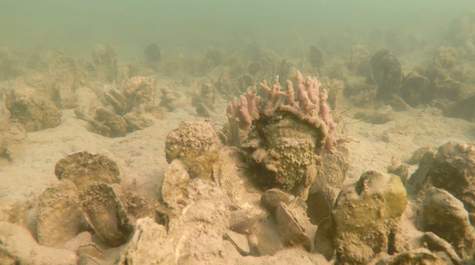Scientists across the Bay have long speculated that oysters improve water quality, leading managers to restore oyster reefs as a best management practice. Researchers Lisa Kellogg and Mark Brush at the Virginia Institute of Marine Science (VIMS) and Jeff Cornwell of the University of Maryland Center for Environmental Science (UMCES) have developed a web-based, interactive computer model to help managers compute the ecological benefits of reef restoration and better plan reef locations. The model was applied to Harris Creek, a Maryland tributary that’s been a hub of oyster restoration in recent years.
The model was designed so that managers could easily enter different restoration scenarios across Harris Creek and calculate the benefits of each outcome. The model is designed to be transferable to other tributaries across the Bay. “Our ultimate goal is to apply the model in each Bay tributary targeted for oyster restoration,” explained Mark Brush, a VIMS scientist who developed the model.

A restored oyster reef in Harris Creek, Maryland. Oyster reefs promote Chesapeake Bay health by clearing the water and providing habitat for many other organisms. L. Kellogg/VIMS. Source
It consists of an estuarine ecosystem simulation model of Harris Creek coupled with an oyster sub-model that computes how oysters filter water, algal cells, and suspended solids, and affect nutrient cycling. Some new features added to the model include data on oyster-mediated nutrient removal specifically from Harris Creek, more recent water quality records, and filtration by mussels and sea squirts, which are both also filter feeders that grow on the reefs.
In order to test the accuracy of the model, the researchers compared estimates from the model to data collected by permanent sensors and field crews, showing that the model does reproduce water quality and oyster growth measurements, particularly on a seasonal basis. Model results showed oyster reefs in Harris Creek have led to a 11.9% decrease in chlorophyll-a concentrations (representing the abundance of algal cells), and a 15.1% decrease in suspended particles in the water column. In total, they found that the reefs “were able to remove more than 100% of the inputs of nitrogen, phosphorous, sediment, and organic carbon from the creek watershed,” said Brush, “plus some of what enters the creek from Chesapeake Bay. It’s an impressive removal of nutrients…the oysters are acting like the kidneys of the creek.”
The team has applied for several grants together over the years to study the ecosystem services provided by oyster restoration. An earlier version of the model was developed as a proof of concept for estimating the Total Maximum Daily Load (TMDL) benefits of oyster restoration, and the latest version, version 2, actually uses data from Harris Creek to better understand the oysters in the context of this ecosystem. Harris Creek was an easy choice to test the model because it is the first tributary in the Bay to host tributary-scale restoration efforts, and because monitoring stations were already set up.
In the future, funding and data allowing, the team hopes to apply the model in more systems around the Bay. Collection of additional data will be critical for refining model formulations. For example, the current model uses a combination of polychaete, mussel, and oyster biomass to estimate denitrification, but the team wants to find a more direct way to predict that rate. “Finding and defining those relationships is important moving forward,” explained Kellogg.
